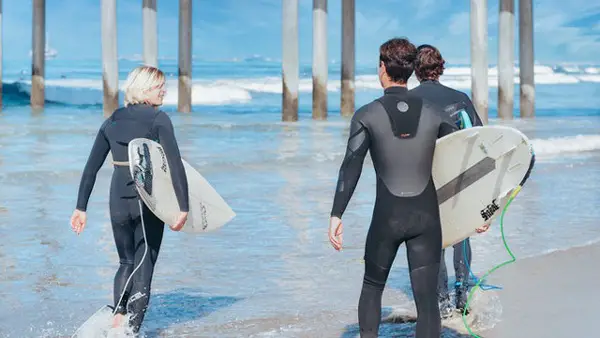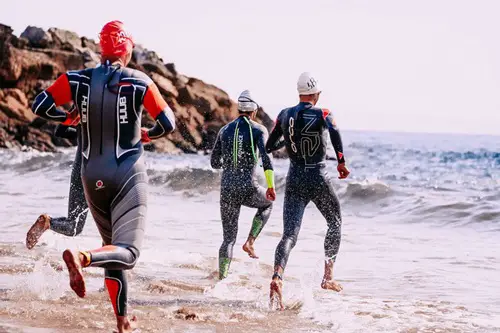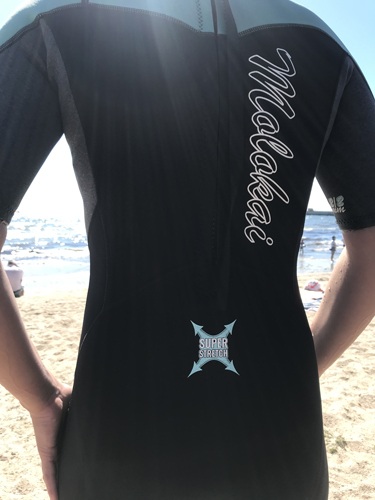What Should I Look for When Buying a Wetsuit?

Wetsuits are designed for a variety of water sports and conditions. Water temperature and the type of water activity will require different wetsuits. So, what should look for when buying wetsuit?
Variations in thickness, styles, and materials should be considered when purchasing a wetsuit. Specialized water sports may require a unique wetsuit design, while simple recreational water activities may be more basic.
This guide is intended to eliminate some of the confusion when purchasing your wetsuit. Our list of wetsuit types may help to remove the stress in purchasing your next wetsuit, or even the first.
What sports activities do you wear a wetsuit in?

A wetsuit is worn for a variety of water sports activities including snorkeling in cold waters. Scuba diving, recreational swimming, surfing, jet skis, triathlons, spearfishing, and water skiing are ideal activities for a wetsuit.
Wetsuits help protect against the cold, help buoyancy and also protect from coral and marine life, like jellyfish.
What types of wetsuits are there?
Warm water snorkeling, kid’s wetsuits, cold water spearfishing, and surfing are some different environments that require different types of wetsuits. The best wetsuit is the one worn for your specific water activity and conditions.
What should I look for when buying a wetsuit is a key question? Let’s take a look at the many different styles and designs available for your ideal wetsuit.
1. Wetsuit Design and Styles
Short John/Jane Wetsuits are ideal for core warmth protection. Designed without sleeves and mid-thigh length provide protection for surfing. Short Johns (Short Janes for ladies) provides added comfort when surfing in cool conditions. They are best suited in tropic waters and Neoprene construction assures added warmth and protection from rashes and sore ribs.
Long John/Jane Wetty wetsuits provide warmth and excellent paddling freedom.
Sleeveless with added leg length these suits are ideal for kayaking, canoeing, Stand up Paddling, or any activity requiring freedom of arm movement.
Spring Suits are perfect for year round paddling activity, depending upon your endurance to cool water. Core warmth protection is provided and flexibility is maintained with mid-length sleeves and legs. Often worn most of the year with little paddle stretch restrictions and added rash protection.
Long Sleeve Spring Suits are for warm waters with cold, windy offshore winds. Long sleeves provide added protection against wind chill and the suit’s short legs allow freedom of movement for body boarders.
Short Arm Steamer wetsuits have short sleeves and full legs. Ideal for transitional weather surfing in the autumn and spring. Designed to provide freedom of arm movement and provide warmth for legs while prone on the board.
Steamer wetsuits cover the entire body and are most efficient for cold waters. Neoprene thickness from 2mm to 7mm provides warmth for varying water conditions.
Steamers may have a split thickness to provide additional warmth to vital areas and less thickness to the areas requiring more movement.
Dry/Semi Dry wetsuits either prevent any water from entering (dry) or very little water (semi dry). Dry wetsuits lock all water out for maximum protection for very cold waters under 15 degrees. Semi dry permits some water to enter and is warmed by the body to maintain warmth.
What wetsuit brands are there?

Here are a few brands available around the world and in the USA:
Billabong Wetsuits started 48 years ago in Australia and today is an international supplier of water sports clothing. Their line of wetsuits includes spring suits, full suits, and wetsuits. Wetsuits vary from 2/2mm to 4/3mm thickness.
Rip Curl was founded in Australia in 1969 as a surfing products company and began wetsuit production in 1970. The surfing background of the company founders led them to focus on wetsuits specifically designed for surfing. Their line-up today consists of a full line of wetsuits including full suits, short arm steamer, long john, short john, and spring suits.
O’Neil wetsuits were founded by Jack O’Neil in 1952 when he developed the first Neoprene wetsuit. Since then, O’Neil has become a world leader in water sportswear. Today O’Neil produces a complete line of wetsuits for various sports activities including triathlons, wake sports, paddle, windsurfing, and scuba diving.
Orca was founded in New Zealand in 1994 and has become a technology leader
in wetsuit manufacturing. Specialization in swimming technology for triathlons, Orca introduced cutting edge innovations such as AirLite and Yamamoto 0.88 Neoprene, Super Composite Skin (SCS), and Infinity Skin 2. Orca wetsuits are technologically advanced and are in the upper price range.
Some other brands available are: Quicksilver Wetsuits, Peak wetsuits, Anchor wetsuits, Patagonia wetsuits, Hurley wetsuits, and Zion wetsuits to name a few.
For free diving and spearfishing, here are some popular brands: Torelli wetsuits, Cressi, Ocean Hunter, Adreno, Omar, Free divers, Huntmaster, Salvimar, Mares and Picasso.
What wetsuit fashions and colors are there?
Wetsuits may still be primarily black for a variety of reasons, but the popularity of colorful wetsuits is rapidly expanding.
Although black is still popular for its warmth, safety, durability, and other reasons, colorful wetsuits are just more fun. A fashionable day at the beach surfing is not the same as wearing a pink, coral, red, or multi-colored suit. Fortunately, manufacturers recognized this trend to more fashionable colors and now practically any color, or color combinations, are available.
While not a fashion statement, spearfishing wetsuits have camouflage patterns to blend in the surroundings to be able to get closer to fish, by blending into the environment.
What wetsuit construction methods are there?
A. Stitching Method Construction.
1. Overlock Stitching – Least expensive and effective stitching method. The wetsuit seams are rolled over and are double stitched with a resultant ridge that may cause irritation. This method of stitching may be found on less expensive Neoprene wetsuits up to 3mm thickness. Overlock stitching also creates a less flexible wetsuit.
2. Flatlock Stitching – Typically found on entry-level wetsuits, this stitching method provides better flexibility with wetsuit layers stitched through. A layer of glue may be applied to reinforce the stitched seam and help in sealing out water from the stitch holes. Flatlock stitched suits are for warmer waters with up to 3mm wetsuits.
3. Blind Stitching – The most comfortable stitching method utilizes glued seams that are reinforced with stitching to create a water tight seal. Found typically on entry and mid-level wetsuits, waterproof blind stitching is appropriate for cold water diving.
B. Sealed Seams Method Construction.
1. Glued Seams – Glued seams may have double, or even triple layers of glue applied to seams before blind stitching. A waterproof, durable, and strong seal is created.
2. Fluid Seams – One of the strongest seals, fluid seams are created by applying liquid rubber to the seals. The liquid seal is applied before the blind stitching process and creates an extremely watertight seal.
3.Taped Seams – Typically found on the interior of wetsuits, taped seams provide extra comfort and are very stretchable. High end taped seams are more water resistant than lower quality taped seams.
Conclusion
Wetsuits help the enjoyment of any water sports activity. And choosing the correct wetsuit based upon an informed decision ensures maximizing your water adventure.
